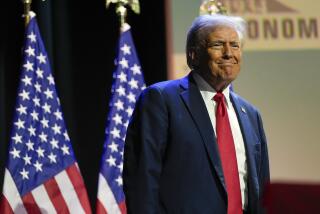Democrats, GOP Forced to Reassess Election Strategy : Campaign: Negative ratings for Bush and Clinton, plus Perot’s challenge, mean old ideas may not work.
This is where the map ends.
After months of political combat, President Bush and Arkansas Gov. Bill Clinton--who clinched the Democratic nomination with his six victories Tuesday--have finally battled their way through the thicket of the primaries, only to find themselves on the shores of uncharted waters.
As they shift their focus toward November, Bush and Clinton are hurtling out into the great wide open: an electoral environment virtually without landmarks. Each man must confront unfavorable ratings from voters that are among the highest for any nominee in modern times, a corrosive sense of dissatisfaction with both parties and, above all, the maverick appeal of Texas businessman Ross Perot--who has ascended to heights in national surveys unprecedented for an independent candidate.
These challenges are compelling both campaigns to reassess the most basic elements of their strategy: how to assemble an Electoral College majority, how to draw distinctions from their rivals--even whether the traditional campaign schedule of racing from media market to media market in a state of permanent jet lag still makes sense when Perot has moved to the front of the line with satellite transmissions, well-timed interviews and appearances with Phil Donahue and Larry King.
On all of these issues, strategists in both camps are re-examining ideas that have been carved in stone for a generation. “Nothing off the shelf is going to work because everything off the shelf was designed for a situation that is radically different,” says Democratic pollster Mark Mellman, who is advising Clinton.
In both parties, political professionals watching Perot’s rise are wondering whether either team has enough candlepower to light a path through such murky terrain. It’s a first in itself: The end of the primaries finds Democrats and Republicans simultaneously lamenting their presidential prospects.
Most professionals at the Bush and Clinton campaigns still believe that Perot will slip--either through his own missteps or through increasingly aggressive media scrutiny. But as Perot remains buoyant in the polls--and demonstrates viability through such dramatic gestures as the hiring of veteran political strategists Edward J. Rollins and Hamilton Jordan on Wednesday--more uncertainty is creeping into those calculations.
Atop the list of uncertainties is the foundation of any presidential campaign: the strategy for assembling the 270 electoral votes needed to win. Over the past generation, the Republicans have built what appears to be a geographical “lock” on the presidency by repeatedly winning most Southern and Western states. In response, Democrats increasingly have looked toward compiling a majority in the Northeast, the Upper Midwest and the West Coast.
With Perot in the race, both of those maps look like artifacts.
Republicans fear that Perot could pick the lock by winning Sun Belt and Rocky Mountain states and by peeling away enough whites to allow Clinton to compete in heavily black Deep South states that the GOP has dominated since 1968.
But the Texas industrialist presents Democrats with as many problems. Bush leads polls in New York, Pennsylvania, Wisconsin and Minnesota--largely because Perot and Clinton are splitting the dissatisfied. In California, Oregon and Washington--three other Democratic targets--Perot leads.
For Clinton and Bush, Perot’s shadow also looms over efforts to distill their messages. In the past, candidates have instinctively attempted to broaden their post-primary appeal to the independent voters who typically decide general elections. But strategists in both camps are questioning whether that approach works in a year in which many of those independents may reject both parties for Perot.
The debate reduces to a basic choice: Is the key to victory in November attracting independents or rallying the base? That strategic decision pivots on a calculation about whether Perot will fade to the point where victory will require nearly half of the popular vote or whether he will remain strong enough to allow someone to win the three-way contest with more like a third of the vote.
Neither side seems confident of the answer. At this point in 1988, Bush had already laid out like so many scalpels the arguments with which he would carve up former Massachusetts Gov. Michael S. Dukakis. But today, many Republicans worry that the Bush campaign seems frozen by the challenge of distinguishing the President from two challengers who do not fit into traditional ideological boxes.
“The White House has no strategy,” one GOP operative says. “They don’t know whether they want to go left or right.”
Clinton faces some of the same problems. He started the race last year targeting suburbanites and better-educated voters with a moderate and cerebral agenda built on rethinking traditional liberalism. But allegations of marital infidelity and draft-dodging damaged his standing with those upscale voters, and former Massachusetts Sen. Paul E. Tsongas quickly moved into the vacuum.
Clinton responded with a populist counterattack that overwhelmed Tsongas. But since Clinton effectively clinched the nomination with his victory in the New York primary, the Arkansas governor has muted the populism and moved back toward his original strategy.
Now, inside the Clinton campaign, strategists are debating whether that relatively nonpartisan appeal makes more sense than a caustic populism intended to rouse traditional Democrats.
Aides to Clinton and Bush also are debating how to use the new means of reaching voters that have emerged this year. Within the political community there is a growing sense that Perot--expanding on ideas first explored this year by former California Gov. Edmund G. (Jerry) Brown Jr.--is defining a new kind of campaign built around direct access to voters through television talk shows and satellite hookups.
“What we’re seeing here,” says Nebraska Sen. Bob Kerrey, one of Clinton’s rivals for the Democratic nomination this year, “is not just Ross Perot but a permanent change in the way people approach running for President.”
Clinton has responded to this sea change more aggressively than Bush. Clinton has already conducted satellite rallies more technically sophisticated than Perot’s, and on Wednesday the Arkansas governor made the latest in a series of appearances on popular culture programs by plopping down on the couch at the Arsenio Hall show.
That’s not the typical place to find a presidential candidate--but, then, this is not a typical election. “Obviously,” one senior Clinton adviser says, “it’s going to be a bizarre campaign.” That may be the year’s safest prediction.
Times staff writer David Lauter contributed to this story.
More to Read
Get the L.A. Times Politics newsletter
Deeply reported insights into legislation, politics and policy from Sacramento, Washington and beyond. In your inbox three times per week.
You may occasionally receive promotional content from the Los Angeles Times.










